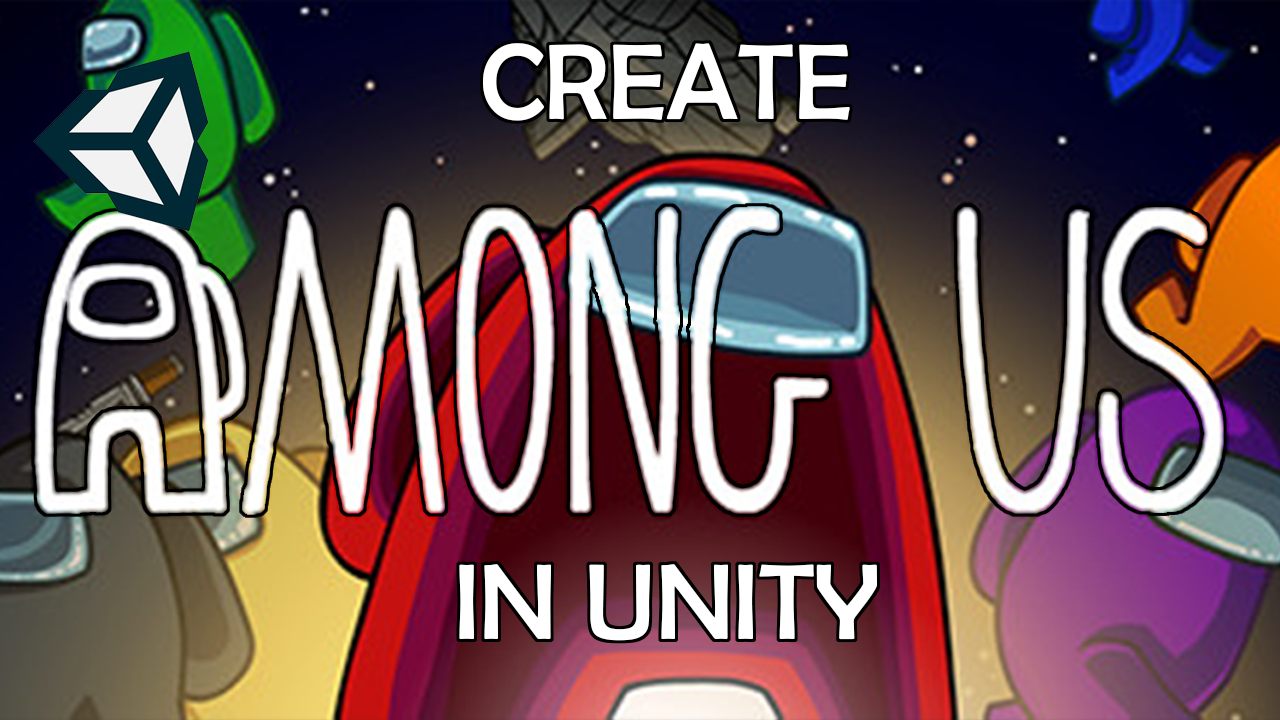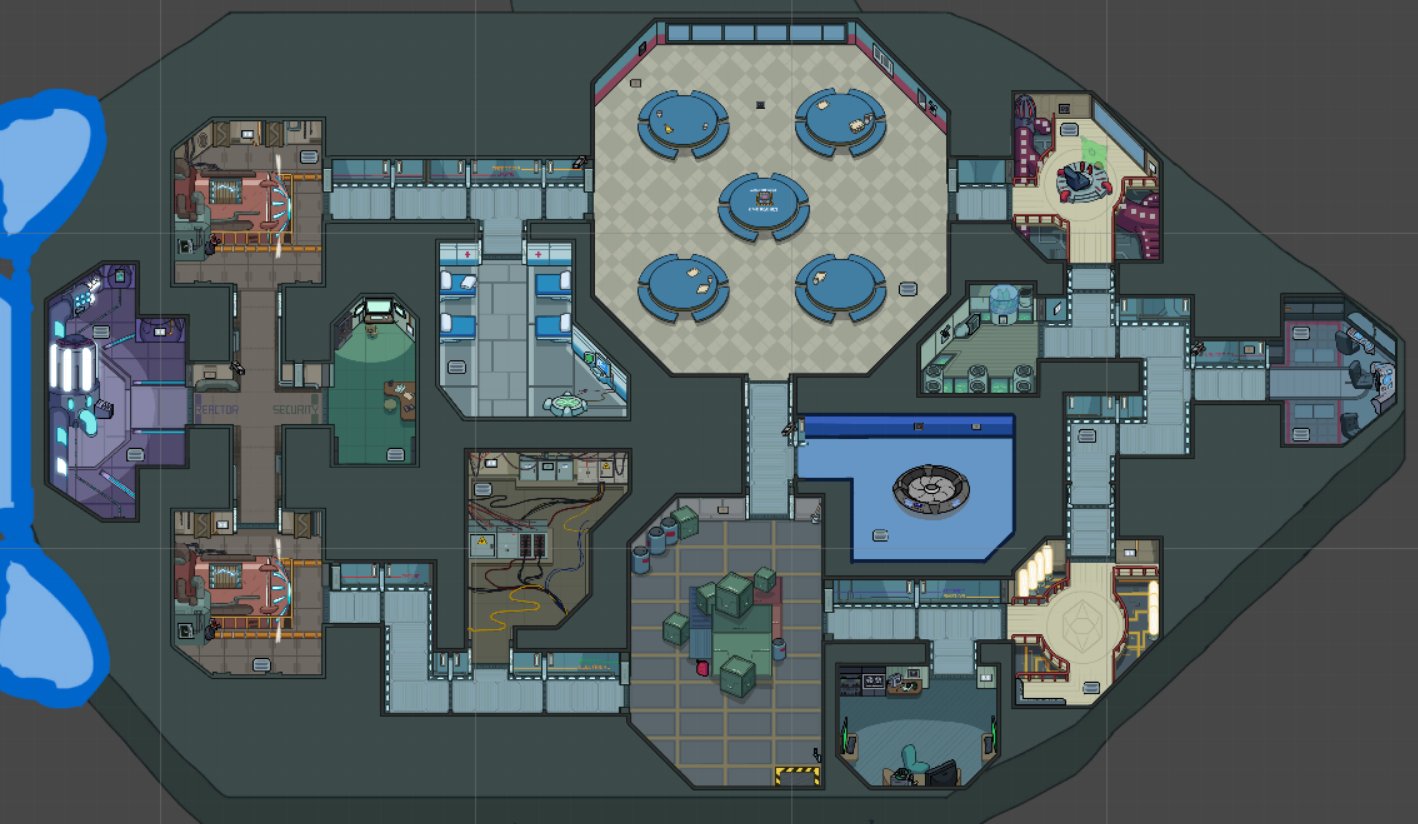
For this lesson on how to make Among Us in Unity, we will go over how to create the report mechanic. This makes it so the player can press a button when they see a dead body and a message will then be sent to report the body.
AU_PlayerController.cs
using System;
using System.Collections;
using System.Collections.Generic;
using UnityEngine;
using UnityEngine.InputSystem;
public class AU_PlayerController : MonoBehaviour
{
[SerializeField] bool hasControl;
public static AU_PlayerController localPlayer;
//Components
Rigidbody myRB;
Animator myAnim;
Transform myAvatar;
//Player movement
[SerializeField] InputAction WASD;
Vector2 movementInput;
[SerializeField] float movementSpeed;
//Player Color
[SerializeField] Color myColor;
SpriteRenderer myAvatarSprite;
//Role
[SerializeField] bool isImposter;
[SerializeField] InputAction KILL;
float killInput;
List<AU_PlayerController> targets;
[SerializeField] Collider myCollider;
bool isDead;
[SerializeField] GameObject bodyPrefab;
public static List<Transform> allBodies;
List<Transform> bodiesFound;
[SerializeField] InputAction REPORT;
[SerializeField] LayerMask ignoreForBody;
private void Awake()
{
KILL.performed += KillTarget;
REPORT.performed += ReportBody;
}
private void OnEnable()
{
WASD.Enable();
KILL.Enable();
REPORT.Enable();
}
private void OnDisable()
{
WASD.Disable();
KILL.Disable();
REPORT.Disable();
}
// Start is called before the first frame update
void Start()
{
if(hasControl)
{
localPlayer = this;
}
targets = new List<AU_PlayerController>();
myRB = GetComponent<Rigidbody>();
myAnim = GetComponent<Animator>();
myAvatar = transform.GetChild(0);
myAvatarSprite = myAvatar.GetComponent<SpriteRenderer>();
if (!hasControl)
return;
if (myColor == Color.clear)
myColor = Color.white;
myAvatarSprite.color = myColor;
allBodies = new List<Transform>();
bodiesFound = new List<Transform>();
}
// Update is called once per frame
void Update()
{
if (!hasControl)
return;
movementInput = WASD.ReadValue<Vector2>();
myAnim.SetFloat("Speed", movementInput.magnitude);
if (movementInput.x != 0)
{
myAvatar.localScale = new Vector2(Mathf.Sign(movementInput.x), 1);
}
if(allBodies.Count > 0)
{
BodySearch();
}
}
private void FixedUpdate()
{
myRB.velocity = movementInput * movementSpeed;
}
public void SetColor(Color newColor)
{
myColor = newColor;
if (myAvatarSprite != null)
{
myAvatarSprite.color = myColor;
}
}
public void SetRole(bool newRole)
{
isImposter = newRole;
}
private void OnTriggerEnter(Collider other)
{
if (other.tag == "Player")
{
AU_PlayerController tempTarget = other.GetComponent<AU_PlayerController>();
if (isImposter)
{
if (tempTarget.isImposter)
return;
else
{
targets.Add(tempTarget);
}
}
}
}
private void OnTriggerExit(Collider other)
{
if (other.tag == "Player")
{
AU_PlayerController tempTarget = other.GetComponent<AU_PlayerController>();
if (targets.Contains(tempTarget))
{
targets.Remove(tempTarget);
}
}
}
private void KillTarget(InputAction.CallbackContext context)
{
if (context.phase == InputActionPhase.Performed)
{
//Debug.Log(targets.Count);
if (targets.Count == 0)
return;
else
{
if (targets[targets.Count - 1].isDead)
return;
transform.position = targets[targets.Count - 1].transform.position;
targets[targets.Count - 1].Die();
targets.RemoveAt(targets.Count - 1);
}
}
}
public void Die()
{
AU_Body tempBody = Instantiate(bodyPrefab, transform.position, transform.rotation).GetComponent<AU_Body>();
tempBody.SetColor(myAvatarSprite.color);
isDead = true;
myAnim.SetBool("IsDead", isDead);
gameObject.layer = 9;
myCollider.enabled = false;
}
void BodySearch()
{
foreach(Transform body in allBodies)
{
RaycastHit hit;
Ray ray = new Ray(transform.position, body.position - transform.position);
Debug.DrawRay(transform.position, body.position - transform.position, Color.cyan);
if(Physics.Raycast(ray, out hit, 1000f, ~ignoreForBody))
{
if (hit.transform == body)
{
//Debug.Log(hit.transform.name);
//Debug.Log(bodiesFound.Count);
if (bodiesFound.Contains(body.transform))
return;
bodiesFound.Add(body.transform);
}
else
{
bodiesFound.Remove(body.transform);
}
}
}
}
private void ReportBody(InputAction.CallbackContext obj)
{
if (bodiesFound == null)
return;
if (bodiesFound.Count == 0)
return;
Transform tempBody = bodiesFound[bodiesFound.Count - 1];
allBodies.Remove(tempBody);
bodiesFound.Remove(tempBody);
tempBody.GetComponent<AU_Body>().Report();
}
}
AU_Body.cs
using System.Collections;
using System.Collections.Generic;
using UnityEngine;
public class AU_Body : MonoBehaviour
{
[SerializeField] SpriteRenderer bodySprite;
public void SetColor(Color newColor)
{
bodySprite.color = newColor;
}
private void OnEnable()
{
if(AU_PlayerController.allBodies != null)
{
AU_PlayerController.allBodies.Add(transform);
}
}
public void Report()
{
Debug.Log("Reported");
Destroy(gameObject);
}
}
using Photon.Chat;
using Photon.Pun;
using System.Collections;
using System.Collections.Generic;
using UnityEngine;
using UnityEngine.UI;
public class PhotonChatManager : MonoBehaviour, IChatClientListener
{
#region Setup
[SerializeField] GameObject joinChatButton;
ChatClient chatClient;
bool isConnected;
[SerializeField] string username;
public void UsernameOnValueChange(string valueIn)
{
username = valueIn;
}
public void ChatConnectOnClick()
{
isConnected = true;
chatClient = new ChatClient(this);
//chatClient.ChatRegion = "US";
chatClient.Connect(PhotonNetwork.PhotonServerSettings.AppSettings.AppIdChat, PhotonNetwork.AppVersion, new AuthenticationValues(username));
Debug.Log("Connenting");
}
#endregion Setup
#region General
[SerializeField] GameObject chatPanel;
string privateReceiver = "";
string currentChat;
[SerializeField] InputField chatField;
[SerializeField] Text chatDisplay;
// Start is called before the first frame update
void Start()
{
}
// Update is called once per frame
void Update()
{
if (isConnected)
{
chatClient.Service();
}
if (chatField.text != "" && Input.GetKey(KeyCode.Return))
{
SubmitPublicChatOnClick();
SubmitPrivateChatOnClick();
}
}
#endregion General
#region PublicChat
public void SubmitPublicChatOnClick()
{
if (privateReceiver == "")
{
chatClient.PublishMessage("RegionChannel", currentChat);
chatField.text = "";
currentChat = "";
}
}
public void TypeChatOnValueChange(string valueIn)
{
currentChat = valueIn;
}
#endregion PublicChat
#region PrivateChat
public void ReceiverOnValueChange(string valueIn)
{
privateReceiver = valueIn;
}
public void SubmitPrivateChatOnClick()
{
if (privateReceiver != "")
{
chatClient.SendPrivateMessage(privateReceiver, currentChat);
chatField.text = "";
currentChat = "";
}
}
#endregion PrivateChat
#region Callbacks
public void DebugReturn(DebugLevel level, string message)
{
//throw new System.NotImplementedException();
}
public void OnChatStateChange(ChatState state)
{
if(state == ChatState.Uninitialized)
{
isConnected = false;
joinChatButton.SetActive(true);
chatPanel.SetActive(false);
}
}
public void OnConnected()
{
Debug.Log("Connected");
joinChatButton.SetActive(false);
chatClient.Subscribe(new string[] { "RegionChannel" });
}
public void OnDisconnected()
{
isConnected = false;
joinChatButton.SetActive(true);
chatPanel.SetActive(false);
}
public void OnGetMessages(string channelName, string[] senders, object[] messages)
{
string msgs = "";
for (int i = 0; i < senders.Length; i++)
{
msgs = string.Format("{0}: {1}", senders[i], messages[i]);
chatDisplay.text += "\n" + msgs;
Debug.Log(msgs);
}
}
public void OnPrivateMessage(string sender, object message, string channelName)
{
string msgs = "";
msgs = string.Format("(Private) {0}: {1}", sender, message);
chatDisplay.text += "\n " + msgs;
Debug.Log(msgs);
}
public void OnStatusUpdate(string user, int status, bool gotMessage, object message)
{
throw new System.NotImplementedException();
}
public void OnSubscribed(string[] channels, bool[] results)
{
chatPanel.SetActive(true);
}
public void OnUnsubscribed(string[] channels)
{
throw new System.NotImplementedException();
}
public void OnUserSubscribed(string channel, string user)
{
throw new System.NotImplementedException();
}
public void OnUserUnsubscribed(string channel, string user)
{
throw new System.NotImplementedException();
}
#endregion Callbacks
}



